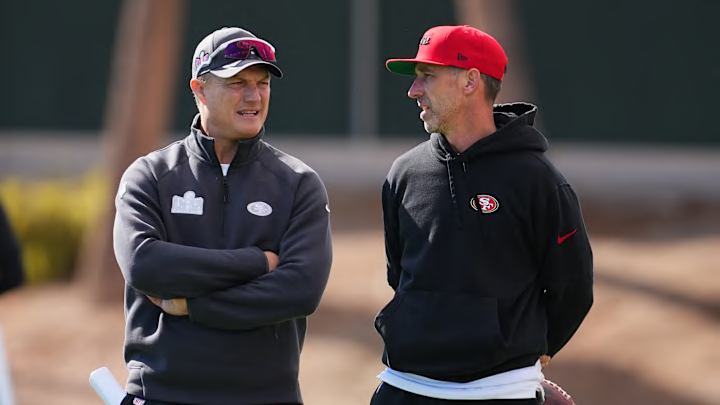The 49ers could theoretically trade up from No. 31 overall in the 2024 NFL Draft, but it might be wiser to stay put.
The San Francisco 49ers haven't had too many instances where they've selected a player at No. 31 overall in the NFL Draft. In fact, the last time they did so was back in 2017 when they traded back into Round 1 and selected Alabama linebacker Reuben Foster.
While that move didn't work out, it shouldn't be a deterrent for general manager John Lynch and head coach Kyle Shanahan.
Entering the 2024 NFL Draft, the Niners own the 31st overall pick, the first of 10 selections currently at their disposal. Considering how stacked the roster is, along with the fact there aren't too many open spots on the projected 53-man roster this season, it makes sense why using some of that draft capital in a trade-up would be in play.
Especially if Lynch and Co. are eyeing a top-flight wide receiver or one of the top prospective offensive linemen who may not slip to No. 31 overall.
But, would it be worth it for San Francisco to send off a number of its mid- and late-round picks to jump up into, let's say, the 20s?
Probably not.
Kyle Posey of Niners Nation explained more in detail:
"When you consider the Niners' potential move to secure a top offensive tackle, it’s a strategic decision. The likes of Tyler Guyton, Amarius Mims, and Kingsley Suamataia could be on their radar, especially if the top four prospects of Joe Alt, Olumuyiwa Fashanu, JC Latham, and Taliese Fuaga are off the board by the top 20 picks.
But what about the cost? Is the prospect worth the potential loss of draft capital? A more precise way to consider a trade-up is by evaluating whether the positional drop-off justifies the sacrifice of your draft capital."
That's an open-ended scenario, one for which Lynch and Shanahan have surely prepared. And the only way to know what happens for certain is by watching how the draft plays out when it kicks off on April 25.
Should one of the 49ers' "dream" targets slip into the 20s, then the chance of a trade-up becomes much more likely.
But it doesn't automatically make it the smartest decision.
Why 49ers are better off staying put at No. 31 overall in NFL Draft
The Niners are increasingly turning into a top-heavy roster, thanks largely to the high number of top-performing players commanding hefty contracts.
It's a good problem to have. San Francisco has talent, and that talent has been rewarded with sizable contracts.
But that situation ultimately means less money spent on depth players and reserves, which can also translate into less of a pipeline of replacement players who can fill the voids left by aging, more-expensive players (see defensive tackle Arik Armstead) who become free agents.
With quarterback Brock Purdy's hefty contract extension looming in a year, the 49ers need to capitalize on those affordable rookie contracts while hoping to find at least a few mid- and late-round gems in this year's class, Purdy (Round 7) being the biggest hidden gem of them all in recent NFL history.
That strategy plays into what the Niners should do at No. 31 overall, as Posey continued:
"Looking at the work Kyle Shanahan and Lynch have done, they’ve been at their best when they stand pat and take the best player available. Let the board come to them. Don’t pigeonhole yourself into one position. If a defensive tackle happens to be the best player available, build on your strength. The same goes with wide receiver, center, etc."
The draft is a craps shoot. First-round prospects can turn into busts just as fast as seventh-round players can turn into perennial Pro Bowlers. While there's a slight skew toward Round 1 prospects being more impactful, it's not a guarantee.
San Francisco is at a crucial point in this year's draft where it needs an influx of young, cheap talent.
The more picks available, the bigger the chance of landing worthy talent regardless of the round.
Trading up from No. 31 overall would grossly hinder the ability to do just that.
